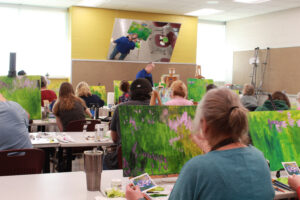David Larkins, MCCC alumnus and local artist, treated community members to a painting workshop and a presentation on his life, inspirations and creations on Feb. 27.
“Every artist has their own little dialect, their own little twang, and that’s what I’m going to show you tonight,” Larkins said.
Larkins hosted the workshop where he led a step by step process of replicating a Monet painting. Later in the day he held a presentation and talked about his life, his works and the stories and meanings behind them.

His piece “Winter Sunrise-Valentine’s Day”, which was inspired by a photograph taken in Monroe County, is the newest addition to the MCCC Art Collection. With this piece being added, the MCCC Art Collection now has Larkins’ work in all three paint mediums, which are oil, watercolor and acrylic.
Larkins attended MCCC starting in 1979, and in his art class is where he first picked up watercolor paints. Up until then he used oil paints, which won him his first blue ribbon when he was 16.
Once he switched to watercolors from oil, he stuck with watercolors until 2003, the year he was awarded a Signature Membership from the National Watercolor Society. After 2003, he switched to acrylic until he was awarded a Signature Membership from the National Oil And Acrylic Painters Society in 2018. Following that award, he switched from acrylic paints back to oil.
When asked about his inspiration and his favored art style called abstract realism, he spoke of late American artist, Andrew Wyeth.
“Andrew Wyeth is my inspiration. He’s kind of my mentor that I never met.”
Larkins said specific photographs also inspire him and his work.

“They jog a memory for me. I see a photograph of someplace we’ve been and I can picture the place, the smell, the time of day, the heat– everything about it, it just jogs all those memories again,” he said. “And then I’ll set the photographs aside and they might sit there for a year, because something has to talk to me about it. I like it for a reason, but what is it?”
Larkins said he wants young artists to know they need to follow their artistic motivations.
“Find something that inspires you, that motivates your creativity, and follow it. Art is a language– a universal language– and you have to find your own dialect,” he said. “Don’t ever forget that, that it is a language, and you have to speak out.”

